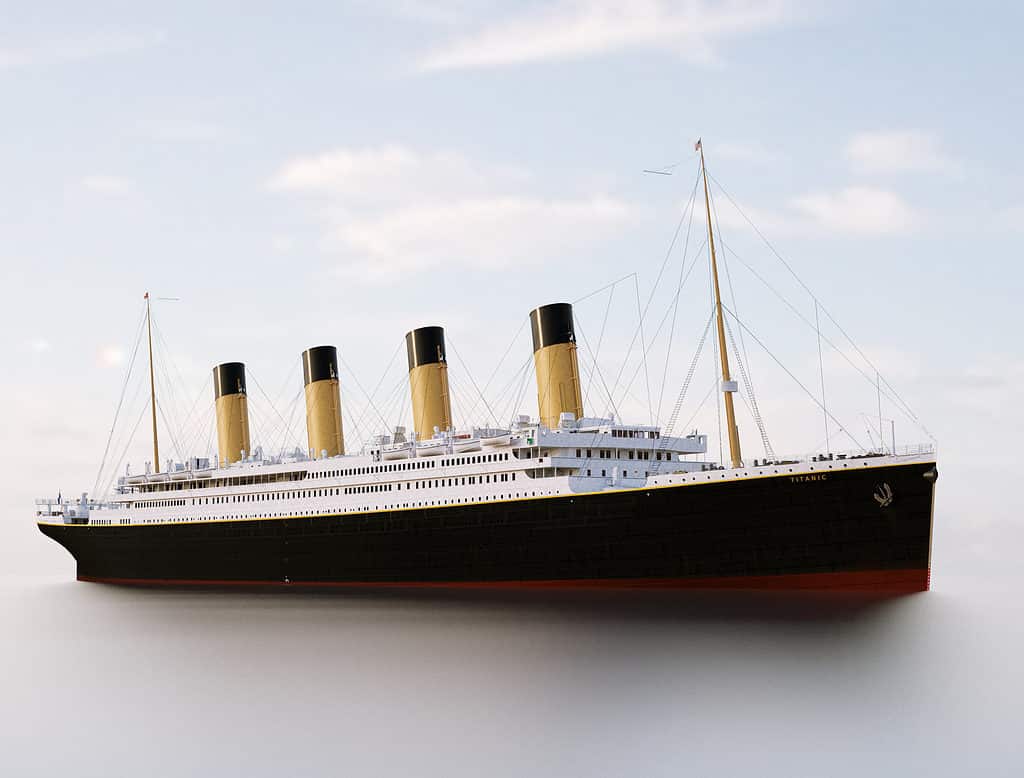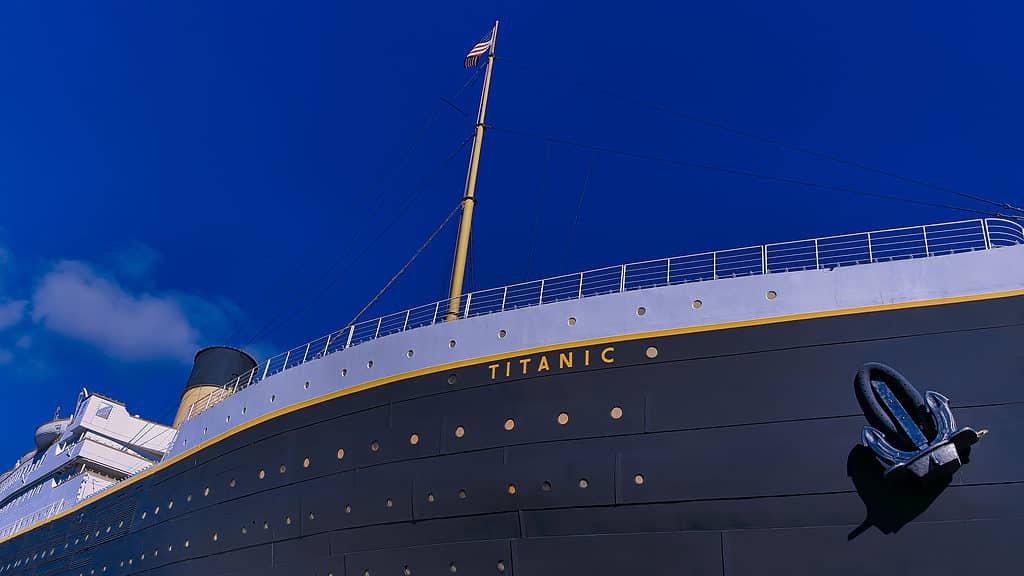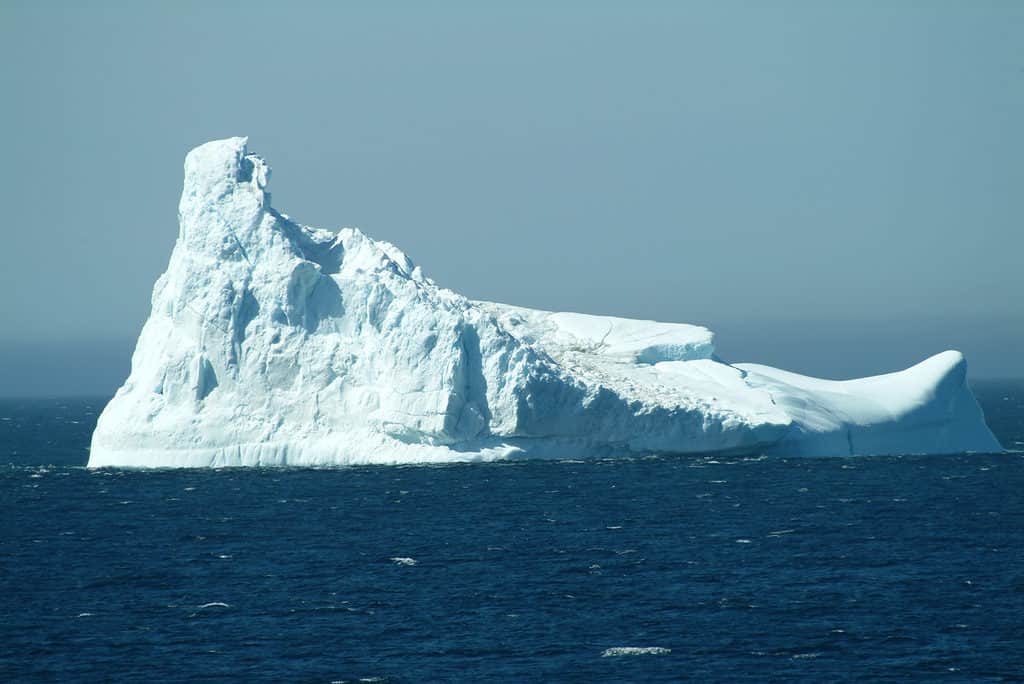About 111 years ago, an ocean liner sank in the North Atlantic after colliding with an iceberg. This tale of the doomed ship and the iceberg that led to its destruction has been recounted countless times. On April 14, 1912, the RMS Titanic, on its maiden voyage across the North Atlantic, hit an iceberg. In just a little over two and a half hours, the ship was lying at the bottom of the Atlantic. The sinking ship took over 1,500 of 2,200 passengers on board with her. This post details some of the events of the unfortunate journey of the Titanic and the iceberg that sank it.

On April 14, 1912, the RMS Titanic, on its maiden voyage across the North Atlantic, hit an iceberg and sank.
©antoniradso/Shutterstock.com
The Sinking of the Titanic
The ill-fated British passenger liner, RMS Titanic, was scheduled to arrive at Pier 59 in New York on April 17, having departed London on Wednesday, April 10. Tragically, it never made it. The unfortunate journey through the freezing waters of the Atlantic came to an abrupt end. The Titanic sank nearly 1,000 miles away from New York. The largest ship at the time was traveling at a speed of about 22 knots when it collided with an iceberg in the North Atlantic. The ship’s doomed descent into the cold icy sea began at about 11:40 p.m. on April 14, 1912.
How Did the Titanic Strike the Iceberg?
Apart from a fire in one of the coal bunkers of the ship, the trip from London to the United States on the Titanic had been uneventful. The ship traveled at an average speed of 21 knots (24 miles per hour) for most of the journey. The weather was also fair. However, the ship crossed a cold weather front with strong winds on the morning of April 14. By the evening of that day, the seas were calm, and the weather was cold.
Other ships in the vicinity had warned the Titanic of drifting ice in the area. This was, however, not a major concern since icebergs hardly ever caused major damage to ships of the Titanic size. Close calls with ice were common, and direct collisions were rarely fatal. Because of this, the ship continued to sail at full speed.
At about 11:40 p.m., Frederick Fleet, one of the lookouts on the ship, spotted an iceberg emerging from the fog just ahead and immediately sounded the alarm. The ship’s captain directed a swift reversal of engines and a rapid turn. Although the Titanic was able to avoid a head-on collision with the iceberg, it skimmed along its side for about seven seconds, scattering ice chunks across the ship’s forward deck.
Since they were able to avoid a head-on collision, the crew felt reassured. Unknown to them, what they had just missed was literally “the tip of the iceberg.” The ice had a sharp underwater spur that sliced a 300-foot gash in the hull below the waterline. By the time the captain of the ship went on a tour of the damaged section, five of the compartments had already begun to fill with saltwater.

The sinking ship took over 1,500 of 2,200 passengers on board with her when it sank.
©Andrea Izzotti/Shutterstock.com
How Much Damage Did the Iceberg That Sank the Titanic Cause?
The iceberg that sank the Titanic struck the ship on the starboard side (right side of the ship). This created a series of holes in the ship’s frame below the waterline. Contrary to what one might expect, the iceberg did not puncture the Titanic’s hull. Instead, the hull was dented so much that the seams began to buckle and separate. This made it possible for water to rush into the ship. Five of the ship’s watertight compartments had been compromised.
The Titanic would have been able to stay afloat if just one or two of the compartments had been exposed. But because so many of them were ripped open simultaneously, the whole forward section of the hull was destroyed. This led to the ship’s sinking.
At 2:20 a.m. on April 15, the Titanic was beneath the sea. Approximately two hours after the Titanic had gone down, the Cunard Line RMS Carpathia arrived at the tragic scene to rescue around 700 survivor passengers.

The iceberg that sank the Titanic struck the ship on the starboard side slicing a 300-foot gash in the hull below the waterline.
©Nan Fry / Flickr – License
How Big Was the Iceberg That Sank the Titanic?
Bernice Palmer took a photograph of the iceberg that was believed to have struck the Titanic. The iceberg was seen by her and other passengers who boarded the Carpathia.
There are varying accounts and estimates for the size of the iceberg that sank the Titanic. According to reports by survivors, the iceberg was about 50 to 100 feet tall and may have been as much as 400 feet long.
On the route to the rescue the next day, the Carpathia reported sailing by an iceberg that was up to 200 feet tall. Although the density of ice in comparison to water indicates that only 10 to 13 percent of an iceberg ought to be above water, the cratered form of most icebergs indicates that the ratio is more like 5:1.
This stability constraint suggests that the vertical thickness of the iceberg could not have been greater than 328 feet. This puts the likely above-water height at around 50 to 60 feet, with a mass of approximately 2 million tons.
Scientists believe that the iceberg in question broke off from a bigger sheet of ice around Qassimiut on Greenland’s southwest coast. It was initially as big as one mile, but after drifting across the fjord for 12 to 36 months, it would have lost half its original size. Based on its trajectory, the iceberg would have eventually melted away when it reached the warm waters of the Gulf Stream approximately two weeks after striking the Titanic.

According to reports by survivors, the iceberg was about 50 to 100 feet tall and may have been as much as 400 feet long.
©David Dennis/Shutterstock.com
Where Did the Titanic Hit the Iceberg That Sank It?
The Titanic was on the final leg of its journey to New York when the iceberg collision occurred. The last stop was at Queenstown, where the ship sailed to Fastnet Rock, then to a spot on the North Atlantic referred to as “the corner” of southeastern Newfoundland.
The ship had only sailed a few hours past the corner to Nantucket Shoals Light when she made contact with an iceberg. It was roughly 193 nautical miles (222 miles) away from Ambrose Light when it sank.
The part of the Atlantic ocean where the Titanic hit the iceberg is often referred to as the “iceberg alley.” The nickname is a reference to the large number of icebergs traveling south through the eastern strait of the Grand Banks off the eastern coast of Newfoundland.
Why Do Ships Crash Into Icebergs?

Icebergs are often underwater completely and hard to see.
©Kertu/Shutterstock.com
Icebergs are large chunks of ice that can appear out of nowhere and can cause significant damage to vessels and other seafaring vessels. A ship crashing into an iceberg is usually the result of the vessel not being able to detect the iceberg in time or the crew being unable to avoid it. There are many famous examples of this happening.
The cause of the collision with the iceberg is mainly due to excessive speed and poor visibility. The ship’s crew may be unable to detect the iceberg in time and unable to slow down the ship before it collides. Such an impact causes numerous holes in the hull of the ship, resulting in the ship taking in significant amounts of water and eventually sinking.
Other reasons for ships crashing into icebergs include human error, bad weather, navigational errors, and equipment malfunction. In some cases, a ship may be too close to an iceberg and unable to maneuver away from it. In other cases, a ship may not be able to detect the iceberg due to bad weather, or the navigation system may be faulty.
Are There Any Other Famous Sunken Ships?

Not everyone knows of the 1914 sinking of the RMS Empress Of Ireland around Sainte-Luce Sur Mer in the Saint-Lawrence River.
©artiste9999/iStock via Getty Images
RMS Empress of Ireland
The RMS Empress of Ireland was a Canadian Pacific Steamships ocean liner that sunk in the St. Lawrence River in 1914. 1,012 passengers and crew members lost their lives in the disaster, making it one of the deadliest maritime accidents in Canadian history. The wreck of the Empress of Ireland still sits in the river, and the tragedy continues to be remembered in Canadian culture.
SS Norge
The SS Norge was a steamship that was sunk in 1904 after colliding with the shore off the coast of Norway. 1,034 people lost their lives in the tragedy, making it one of the deadliest peacetime maritime disasters in history. The wreck of the SS Norge was discovered in 1995, and it is now a popular attraction for scuba divers.
SS Athenia
The SS Athenia was an ocean liner that was sunk by a German U-boat in 1939, shortly after the start of World War II. Although the Germans initially denied responsibility, it was later revealed that the ship had been sunk by a torpedo. Around 117 passengers and crew members lost their lives in the disaster. The wreck of the SS Athenia was discovered in 1998, and the tragedy continues to be remembered in history.
The photo featured at the top of this post is © Denis---S/Shutterstock.com
Thank you for reading! Have some feedback for us? Contact the AZ Animals editorial team.






